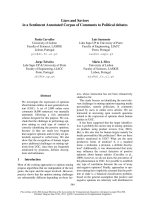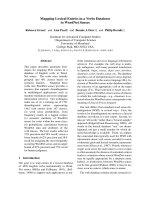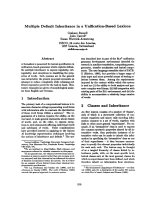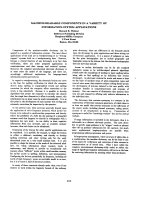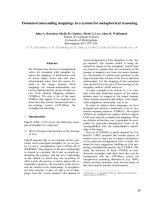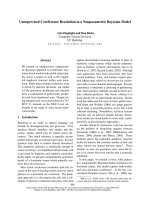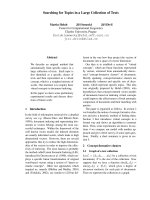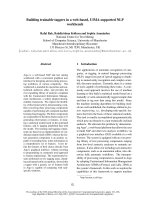báo cáo khoa học: "Reverse end-diastolic flow in a fetus with a rare liver malformation: a case report" pps
Bạn đang xem bản rút gọn của tài liệu. Xem và tải ngay bản đầy đủ của tài liệu tại đây (543.25 KB, 4 trang )
CAS E REP O R T Open Access
Reverse end-diastolic flow in a fetus with a rare
liver malformation: a case report
Antonella Giancotti
*
, Antonella Spagnuolo, Valentina D’Ambrosio, Gaia Pasquali, Brunella Muto,
Francescantonio Bisogni, Renato La Torre, Maurizio Marco Anceschi, Fabrizio De Gado
Abstract
Introduction: We describe a case of early and persistent reverse end-diastolic flow in the middle cerebral artery in
a fetus with severe ascites. These features are associated with a rare liver malformation kno wn as ductal plate
malformation.
Case presentation: A 28-year-old Caucasian woman was referred to our high-risk obstetric unit at 24 weeks’
gestation for fetal ascites detected during a routine ultrasound examination. During her hospitalization we
performed medical investigations, including a fetal paracentesis, to detect the etiology of fetal ascites. The cause of
fetal ascites (then considered non-immune or idiopathic) was not evident, but a subsequent ultrasound
examination at 27 weeks’ gestation showed a reverse end-diastolic flow in the middle cerebral artery witho ut any
other Doppler abnormalities. A cesarean section was performed at 28 weeks’ gestation because of the
compromised fetal condition. An autopsy revealed a ra re malformation of intrahepatic bile ducts known as ductal
plate malformation.
Conclusion: Persistent reverse flow in the middle cerebral artery should be considered a marker of adverse
pregnancy outcome. We recommend careful ultrasound monitoring in the presence of this ultrasonographic sign
to exclude any other cause of increased intracranial pressure. To better understand the nature of these
ultrasonographic signs, additional reports are deemed necessary. In fact in our case, as confirmed by
histopathological examination, the fetal condition was extremely compromised due to failure of the fetal liver.
Ductal plate malformation altered the liver structures causing hypoproteinemia and probably portal hypertension.
These two conditions therefore explain the severe hydrops that compromised the fetal situation.
Introduction
Our study analyzes a case of reverse end-diastolic flow
in the middle cerebral artery (MCA) in a fetus at
26 weeks’ gestation with a previous diagnosis of idio-
pathic ascites. This particular ultrasound pattern was
associated with a rare liver abnormality known as ductal
plate malformation (DPM). This condition is a rare mal-
formation of intrahepatic bile ducts (IHBDs) due to an
arrest or failure of epitheliomesenchymal inductive
interactions. Immature bile ducts are subject to a pro-
gressive destructive cholangiopathy, resulting in a pat-
tern of a more or less advanced fetal type of liver
fibrosis [1]. The disequilibrium of the portobili ary
system is often associated with autosomal recessive
polycystic kidney disease or other fibrocystic malfo rma-
tion of the liver or kidneys, even if it has also been
reported as an isolated entity [2] that is usually not
identified by prenatal ultrasound examination. Only in
rare cases of prenatal onset fetal liver cysts can be see n,
and an ultrasound scan is the most useful method in
showing the kidneys’ anomalies associated with renal
disease [3]. Reverse flow in the MCA is usually a transi-
ent event. The occurrence of this particular waveform
can be explained by a few possible mechanisms that
could alter cerebral blood circula tion. Reverse flow
could be a consequence of any elevated pressure condi-
tion outside or inside the brain. An elevation of external
pressure can be due to mechanical compression of the
fetal head by the transducer, which may induce a
reverse flow that causes a high impedance to blood flow
in the cerebral circulation [4]. External pressure may be
* Correspondence:
Department of Obstetrics and Gynecology, “Sapienza” University Umberto I
Hospital, Viale del Policlinico, 155, 00161 Rome, Italy
Giancotti et al . Journal of Medical Case Reports 2011, 5:37
/>JOURNAL OF MEDICAL
CASE REPORTS
© 2011 Giancotti et al; licensee BioMed Central Ltd. This is an Open Access article distributed under th e terms of the Creative
Commons Attribution License ( , which permits unrestricted use, distri bution, and
reproduction in any medium, provided the original work is properly cited.
increased also in the presence of an extended oligohy-
dramnios or anhydramnios [5]. An increase in internal
pressure can be due to the occurrence of hydrocephalus,
cerebral edema, or cerebral hemorrhage. All of these
pathological events can explain reverse flow in the MCA
[6,7]. Reverse flow could also represent the extreme
form of a brain-sparing mechanism before fetal death in
case o f intra-uterine growth restriction (IUGR) [8]. The
other elements that can explain the reversal of flow in
the MCA include abnormal fetal heart rate, the presence
of tricuspid regurgitation, maternal drug effect, and tem-
porary changes in fetal blood pressure after invasive
intra-uterine procedures [9].
Case presentation
A 28-year-old Caucasian woman, gravida 4, para 1, was
referred to our high-risk obstetric unit at 24 weeks’
gestation for fetal ascites detected during a routine
ultrasound examination. Her personal and family history
did not reveal any pathology of note. Her first preg-
nancy ended with an intra-uterine death at 23 weeks’
gestation caused by chorioamnionitis. In the second
pregnancy, a live baby g irl was delivered at 40 weeks’
gestation. Four years later our patient had a sponta-
neous miscarriage. Our patient denied any fever, rash,
cold symptoms, or joint pain before and during preg-
nancy. She did not refer to any vaginal bleeding. Labora-
tory tests for Toxoplasma and rubeola showed negative
immunoglobulin M (IgM). An ultrasound examination
performed during the consultation confirmed the pre-
sence of abdominal ascites (Figure 1). A borderline
monolateral dilation of the cerebral ventricle was also
seen. Biometry of the fetal limbs was below the mean in
relation to gestational age, while cephalic measurements
were normal. No other fetal anomalies were observed.
Amniotic fluid was present in adequate quantity,
but fetal movements were poor. For these reasons,
the woman was admitted to our institution for close
pregnancy monitoring. During hosp italization, her blood
pressure and heart frequency were measured several
times during the day, while cardiotocography was per-
formed twice a day. Maternal blood pressure was nor-
mal, and there was no proteinuria. Investigation about
the etiology of the fetal ascites were carried out, and a
fetal paracentesis was also performed. Both parents had
normal mean corpuscular erythrocyte volume with no
sign of microcythemia and they both had positive blood
group Rh without any pathologic antibodies. A routine
blood laboratory assessment did not show any kind of
abnormalities. Viral serology markers (cytomegalovirus
IgG and IgM, parvovirus IgG and IgM) were negative in
the maternal blood, and no viral genome was isolated in
her amniotic fluid or the fetal ascites sample. The fetal
karyotype was normal (46, XY). A Kleihauer-Betke test
showed no evidence of fetal erythrocytes in the maternal
circulation. Immunologic markers, lupus anticoagulant
anticardiolipin, antinuclear, and anti-RO antibodies were
negative; G6PD was also excluded. There was no evi-
dence regarding the cause of fetal ascites (then consid-
ered non-immune or hydiopatic). Only a mild increase
in inflammation indices was noted (VES 40, PCR 7.325);
an antibiotic preventive treatment was performed for
five days ( sulbactam/ampicillin 1.5 mg three times daily,
gentamicin 80 mg three times dail y, metronidazole
500 mg three times daily). During hospitalization, detailed
ultrasound scans were performed at least every two days
to monitor the ascites and general cond ition of the fetus.
Fetal middle cerebral artery peak systolic velocity (PSV)
was measured to diagnose fetal anemia. Pulsatility index
(PI) of either the umbilical artery (UA) or the MCA as
well as the resistance index of uterine arteries were
assessed to better evaluate the materno-fetal perfusion.
Monitoring scans showed a deterioration of fetal condi-
tion. Paracentesis was performed at 25 weeks’ gestation,
but two days later the fetal ascites occurred again. A
restriction of fetal growth and progressive reduction of
amniotic fluid were a lso registered. The value of PSV in
the MCA was borderline for moderate to severe anemia
according to Mari’ s chart [10], whereas fetal D oppler
ultrasound parameters were normal. At 27 weeks’ gesta-
tion, a reverse end-diastolic flow in the MCA occurred
(Figure 2). This abnormal waveform pattern persisted for
all the ultrasound examinations, and it was not associated
with other Doppler abnormalities (PI UA 1.15, PI MCA
1.54). The condition was interpreted as ‘at risk’,andour
patient was submitted to closer monitoring. Fetal echocar-
diography showed cardiomegaly without significant
abnormality of heart structures and a mild tricuspid regur-
gitation. Cardiotocography monitoring showed fetal brady-
cardia (fetal heart rate 100 beats per minute). Our patient
was submitted to fetal magnetic resonance imaging to
Figure 1 Sonogram showing fetal ascites.
Giancotti et al . Journal of Medical Case Reports 2011, 5:37
/>Page 2 of 4
investigate in particular the brain edema, and this con-
firmed the presence of fetal ascites without showing any
abnormality of fetal cerebral tissue or signs of hypoxia.
Corticosteroid treatment (betamethasone 12 mg for two
days) was started because of a high risk for preterm
delivery. After one week, ultrasoun d parameters showed
a severe decrease in fetal weight (<fifth percentile), an
increase in fetal ascites, and subcutaneous edema. The
reversed end-diastolic flow in the MCA persisted, and an
increase of PI UA was detected. Alterations of ductus
venosus waveform appeared, and an inversion of “ a”
wave was identified. The amniotic fluid index was below
the mean f or gestational age. The biophysical profile
examination was un satisfactory. The seve re prognosis
was explained to the couple, and an active intervention
was ruled out. The fetus was in breech presentation at
this time. Our patient was submitted to an emergency
cesarean section at 28 weeks’ gestation. A live baby boy
in poor general condition was delivered. The Apgar score
was one and five. Intubation was neces sary, but despite
neonatal intensive care, the baby died a few hours after
birth. An autopsy revealed a rare malformation of IHBDs
known as DPM. No other anom aly was identified.
Discussion
Currently, Doppler ultrasound is widely used to study
fetal circulation in both normal and pathological preg-
nancy. With regard to fetal cerebral circulation, quanti-
tative and qualitative estimations of the MCA blood
flow are usually performed. Blood flow impedance is
studied in terms of PI in relation to gestational age; the
qualitative assessment consists of a valuation of present,
absent, or reverse blood flow during the diastole.
Reverseend-diastolicflowintheMCAisusuallyarare
and transient event. In the majority of cases, the cause
of this abnormal waveform pattern remains unknown
even when increased cerebral pressure is considered.
Sepulveda et al. [11] considered reverse flow in the
MCA an agonal sign in the human fetus. They docu-
mented the first case in the literature of reverse end-
diastolic flow in a severely growth-restricted fetus that
appeared the day before fetal death. Leung et al. [12]
documented this pattern waveform as a transient event
in a severe IUGR fetus at 24 weeks’ gestation. During
the observation, the fetus was in breech presentation.
Reverse flow in the MCA disappeared the day after,
when the fetus modified its presentation in a cephalic
one and did not come out again in the subsequent Dop-
pler studies. These authors underlined that the fetus
was in breech presentation when the reverse flow
occurred in the MCA, whereas it was in cepha lic pre-
sentation before and after. De Spirl et et al.[13]
described a case of p ersistent reverse end-d iastolic flow
in a fetus with subdural hematoma due to severe throm-
bocytopenia. Respondek et al. [9] analyzed the outcome
of 22 fetuses with reversal of diastolic flow i n the MCA.
The authors concluded that, in the majority of cases,
this phenomenon is not related to fetal pathology, mor-
bidity, and mortality. In their case, an intra-uterine
death was observed in a fetus with a prolonged reverse
flow in the MCA. In our case, we carefully minimized
the transducer’s pressure when the reversal of diastolic
flow in the MCA appeared. We also used two different
types of ultrasound equipment and either a trans-vaginal
or trans-abdominal a pproach. No uterine contractions
were observed during the examination. Despite all of
these efforts, the waveform patterns persisted for the
duration of ultrasound exami nation. The fetus also pre-
sented with bradycardia (<100 beats per minute) and a
mild tricuspid regurgitation assessed during the echocar-
diography. This regurgitation was defined as not signifi-
cant for the hemodynamic status of the fetal heart, and
we assume that this was not correlated to the reversal of
diastolic flow in the MCA. The peculiarity in this case
was that in our patient, reverse flow in the MCA per-
sisted for over one week and was not associated with
reverse flow in the UA. However, it could be related to
a deterioration of fetal condition.
Conclusions
We agree with Sepulveda et al. [11] in considering
reverse end-diastolic flow in the MCA a sign of poor
fetal outcome. In fact , as confirmed by histopathological
examination, the fetal condition in our case was extre-
mely compromised by failure of the fetal liver. The
DPM altered the liver structures, causing hypoproteine-
mia and probably portal hypertension. These two condi-
tions can explain the severe hydrops that compromised
the fetal condition. According to the literature, no ultra-
sound sign of liver disease can be seen on prenatal
ultrasound examination [3]. To the best of our
Figure 2 Sonogram showing reverse flow in the MCA.
Giancotti et al . Journal of Medical Case Reports 2011, 5:37
/>Page 3 of 4
knowledge, there is only one case in the literature of
fetal ascites associated with DPM [14]. In that case, the
massive ascites appeared later in gestation (33 weeks),
and the baby died at 36 days of life despite intensive
neonatal care. Regarding our experience, isolated and
persistent reverse flow in the MCA should be consid-
ered a marker of adverse pregnancy outcome. In this
condition, we recommend close u ltrasound monitoring
to exclude any cause of increased intracranial pressure
and to identify other signs of impending fetal adverse
outcome. We recommend repeated ultrasound and Dop-
pler assessments at not more than daily intervals. To
better understand the nature of this ult rasound sign and
its relation with poor fetal outcome, additional reports
are deemed necessary.
Consent
Written informed consent was obtained from the patient
for publication of this case report and accompanying
images. A copy of the written consent is available for
review by the Editor-in-Chief of this journal.
Abbreviations
DPM: ductal plate malformation; IHBD: intrahepatic bile duct; Ig:
immunoglobulin; IUGR: intra-uterine growth restriction; MCA: middle cerebral
artery; PI: pulsatility index; PSV: peak systolic velocity; UA: uterine artery
Authors’ contributions
AG contributed to the concept and design of the case report; AS
contributed to the design of the case report, revisiting the manuscript
critically for important intellectual content; VD contributed to the collection
and interpretation of data and made a major contributor to writing the
manuscript; GP contributed to the collection and interpretation of data and
contributed to writing the manuscript; BM contributed to the interpretation
of data; FB contributed to the interpretation of data; RLT contributed to the
critical writing and revisited the intellectual content; MMA contributed to
the critical writing and revisiting the intellectual content; FDG revisited the
manuscript critically for important intellectual content. All author s read and
approved the final manuscript.
Competing interests
The authors declare that they have no competing interests.
Received: 23 February 2010 Accepted: 27 January 2011
Published: 27 January 2011
References
1. Awasthi A, Das A, Srinivasan R, Joshi K: Morphological and
immunohistochemical analysis of ductal plate malformation: correlation
with fetal liver. Histopathology 2004, 45(3):260-267.
2. Shorbagi A, Bayraktar Y: Experience of a single center with congenital
hepatic fibrosis: a review of the literature. World J Gastroenterol 2010,
16(6):683-690.
3. Gunay-Aygun M, Gahl WA, Heller T: Congenital hepatic fibrosis overview.
In GeneReviews [Internet]. Edited by: Pagon RA, Bird TC, Dolan CR, Stephens
K. Seattle (WA): University of Washington, Seattle; 1993.
4. Vyas S, Campbell S, Bower S, Nicolaides KH: Maternal abdominal pressure
alters fetal cerebral blood flow. Br J Obstet Gynaecol 1990, 97(8):740-742.
5. Jakobovits A, Jörn H: [Doppler color sonography in the study of fetal
cerebral circulation in oligohydramnios]. Orv Hetil 1993,
134(39):2139-2142.
6. Jakobovits AA: Reverse flow in the fetal middle cerebral artery. Am J
Ostet Gynecol 1997, 176(2):497-498.
7. Vyas S, Nicolaides KH, Bower S, Campbell S: Middle cerebral artery flow
velocity waveforms in fetal hypoxaemia. Br J Obstet Gynaecol 1990,
97(97):797-803.
8. Mari G, Wasserstrum N: Flow velocity waveforms of the fetal circulation
preceding fetal death in a case of lupus anticoagulant. Am J Obstet
Gynecol 1991, 164(3):776-778.
9. Respondek M, Woch A, Kaczmarek P, Borowski D: Reversal of diastolic flow
in the middle cerebral artery of the fetus during the second half of
pregnancy. Ultrasound Obstet Gynecol 1997, 9(5):324-329.
10. Detti L, Mari G, Akiyama M, Cosmi E, Moise KJ Jr, Stefor T, Conaway M,
Deter R: Longitudinal assessment of the middle cerebral artery peak
systolic velocity in healthy fetuses and in fetuses at risk for anemia. Am
J Obstet Gynecol 2002, 187(4):937-939.
11. Sepulveda W, Shennan AH, Peek MJ: Reverse end-diastolic flow in the
middle cerebral artery: an agonal pattern in the human fetus. Am J
Obstet Gynecol 1996, 174(5):1645-1647.
12. Leung WC, Tse KY, Tang MH, Lao TT: Reversed diastolic flow in the
middle cerebral artery: is it a terminal sign in a growth-retarded fetus?
Prenat Diagn 2003, 23(3):265-267.
13. de Spirlet M, Goffinet F, Philippe HJ, Bailly M, Couderc S, Nisand I: Prenatal
diagnosis of a subdural hematoma associated with reverse flow in the
middle cerebral artery: case report and literature review. Ultrasound
Obstet Gynecol 2000, 16(1):72-76.
14. Rosgaard A, Mertz H, Skovbo P, Ebbesen F: Intra-uterine ascites associated
with ductal plate malformation of the liver. Eur J Pediatr 1996,
155(11)
:990-991.
doi:10.1186/1752-1947-5-37
Cite this article as: Giancotti et al.: Reverse end-diastolic flow in a fetus
with a rare liver malformation: a case report. Journal of Medical Case
Reports 2011 5:37.
Submit your next manuscript to BioMed Central
and take full advantage of:
• Convenient online submission
• Thorough peer review
• No space constraints or color figure charges
• Immediate publication on acceptance
• Inclusion in PubMed, CAS, Scopus and Google Scholar
• Research which is freely available for redistribution
Submit your manuscript at
www.biomedcentral.com/submit
Giancotti et al . Journal of Medical Case Reports 2011, 5:37
/>Page 4 of 4
